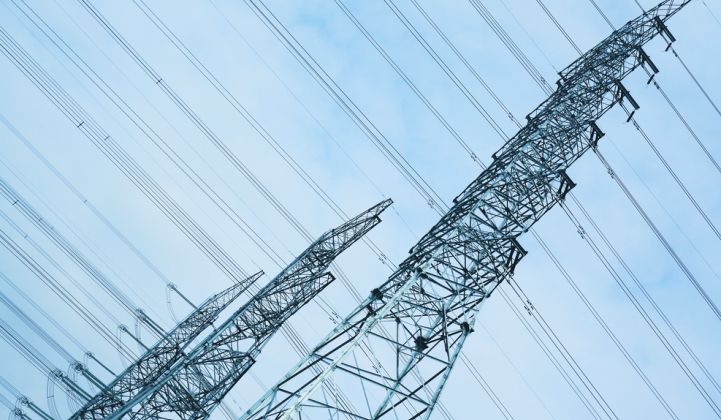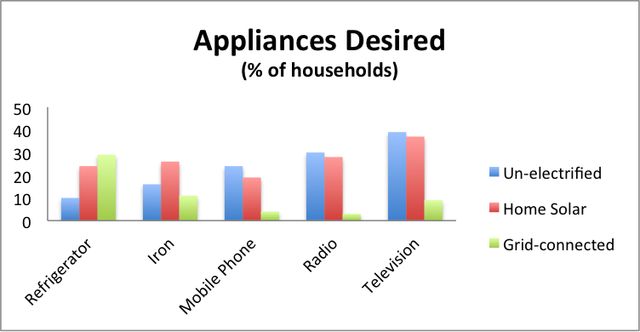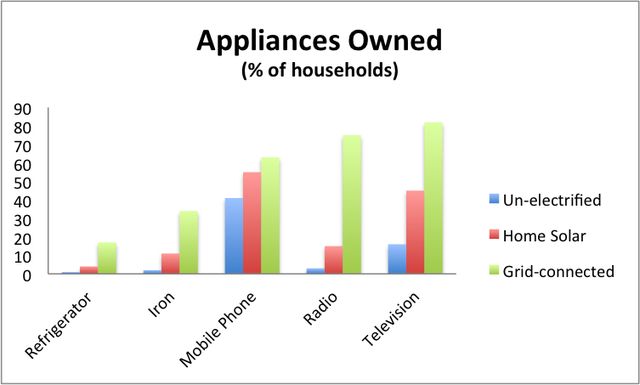A recent article in the New York Times describes how a solar home provider will “help some of the 1.2 billion people in the world who don’t have electricity to leapfrog the coal-dependent grid straight to renewable energy sources.”
One of the reasons I object to the "leapfrogging" term is that, at least given current technologies, home solar systems do not provide anywhere close to the same level of service as electricity from the grid. By contrast, a mobile phone, the oft-cited analogy in the leapfrogging discussions, has at least one notable advantage over a landline -- it’s mobile.
Together with my co-authors Ken Lee and Ted Miguel, I just released a working paper that provides direct evidence that home solar users have not leapfrogged the grid.
We surveyed over 2,500 rural households in western Kenya, some of which had grid connections, some of which had home solar systems and some of which were un-electrified.
Households in the “home solar” category had either a solar lantern or a small solar home system. They had paid on average $55 for the solar lanterns and $235 for solar home systems – a lot of money to households whose average annual incomes are likely less than $1,000. Many of them probably have the M-KOPA system, as it’s the most popular in Kenya. It currently costs over $200 and provides an 8-watt panel, two LED bulbs, an LED flashlight, a rechargeable radio and mobile charging adapters.
Here’s what we found.
People want high-wattage appliances, such as irons. We asked households to list all of the electrical appliances they own. We then asked them to name the appliance that they would ideally purchase next (that they did not currently own). The chart below shows the most desired appliances among the three groups in our study: grid-connected, home solar and un-electrified.
For both the home solar and the un-electrified households, televisions and radios are the most coveted appliances. These do not have to be high-wattage, although even a pretty efficient small television at 15 watts is asking too much from the typical 8-watt home solar system in Kenya. Irons, which are the third most desired appliance among home solar households and the fourth most desired appliance among un-electrified households, are very high-wattage -- typically 1,000 to 1,500 watts.
We also asked the households about their general standard of living, and the home solar users appear richer and better educated than un-electrified households. These higher living standards, however, do not translate into meaningful differences in appliance ownership.
The set of appliances owned by home solar households is much more similar to un-electrified households than the households with grid connections. The set of appliances that home solar and un-electrified households most desire is exactly the same as the set of appliances most likely to be owned by households with grid connections: televisions, radios, mobile phones, and -- you guessed it -- irons. The grid accommodates high-wattage appliances like irons because it has a large capacity and because not everyone uses an iron at the same time, so households can share the infrastructure. So, it looks like both home solar and un-electrified households aspire to the energy consumption of a grid-connected household.
Home solar owners still use almost as much kerosene as un-electrified households. We asked households how much kerosene they had purchased in the past month. Kerosene is primarily used for lighting in our sample -- almost none of the households report cooking with kerosene. So, we would expect to see a substantial drop in kerosene consumption for a household with electric lighting.
On average, un-electrified households had spent $3.90 on kerosene, while home solar households had spent $3.41. Perhaps the home solar owners are still buying kerosene to light additional rooms or to compensate for days when they cannot charge their solar systems. A greater share of home solar customers reported spending nothing on kerosene -- almost 25 percent compared to 3 percent of un-electrified households, though this implies that three-quarters of the home solar owners are still relying on kerosene.
I’m not opposed to solar lanterns or solar home systems. For some households, they provide a real improvement over kerosene lighting. Most solar solutions seem to be priced to give households slight savings compared to buying kerosene. And, to the extent households are using less kerosene, they’re exposed to less indoor air pollution and lower risks of fire or burns. However, they are best described as incremental steps up the energy ladder, rather than leapfrogging.
The Center for Global Development describes recent research that makes a similar point. The center found that nearly 90 percent of households in Tanzania that already had “access to electricity outside of the national grid, such as solar power” still wanted a connection to the national grid. The researchers also link to an article that describes villagers with a solar microgrid in India who still want “real” electricity, by which they mean grid-provided power.
Certainly, grid connections offer very different levels of service, depending on reliability levels. We did not see this in our data, but it’s conceivable that households would have both a home solar system and a grid connection -- using the home solar system for basic lighting and cell-phone charging when the grid was unavailable. Fortunately, the World Bank is starting to collect data that will elicit more information on the different levels of services that households experience.
Our paper also provides perspective on the potential environmental benefits of home solar. If we’re thinking of home solar as an alternative to a grid connection, it’s important to know how the grid electricity is generated. Over 60 percent of the existing generation in Kenya and other parts of sub-Saharan Africa comes from hydro, geothermal and other non-fossil-fuel sources.
So pushing households to home solar in sub-Saharan Africa may not save nearly as much fossil fuel as some proponents would have you believe. But just because sub-Saharan African grids are green now, that does not mean they will continue to be. If all the new generation is expected to come from coal, home solar could have large benefits by offsetting this marginal generation.
We looked at countries’ plans for growing their grids and saw that most countries are projecting they’ll get an even higher fraction of their generation from non-fossil sources over the next 10 to 20 years (see Figure 2B in the paper).
Think of it this way. As countries in sub-Saharan Africa develop, they will need more and more electricity to power manufacturing facilities, high-rise office buildings, subway systems, and all the (mostly urban) residential customers who are already connected to the grid. To meet environmental goals, we need to figure out a way to supply that power with as little emissions as possible. But as long as we’re trying to de-carbonize the grid, providing rural households with home solar systems doesn’t provide many environmental benefits and may even distract from attempts to, for instance, build grid-scale solar.
So let’s stop talking about leapfrogging and help more people get access to “real” electricity.
***
Catherine Wolfram is the Cora Jane Flood Professor of Business Administration and Faculty Director at the Haas School of Business at the University of California at Berkeley.
Reprinted with permission. Original column appears here.





